


Jenkins plugin to run dynamic agents in a Kubernetes cluster.
Based on the Scaling Docker with Kubernetes article, automates the scaling of Jenkins agents running in Kubernetes.
The plugin creates a Kubernetes Pod for each agent started, and stops it after each build.
Agents are launched as inbound agents, so it is expected that the container connects automatically to the Jenkins controller. For that some environment variables are automatically injected:
JENKINS_URL : Jenkins web interface url JENKINS_SECRET : the secret key for authentication JENKINS_AGENT_NAME : the name of the Jenkins agent JENKINS_NAME : the name of the Jenkins agent (Deprecated. Only here for backwards compatibility)Tested with jenkins/inbound-agent, see the Docker image source code.
It is not required to run the Jenkins controller inside Kubernetes.
📜 Table of ContentsGeneric setup Usage Configuration reference Inheritance Declarative Pipeline Misc. Running on OpenShift Features controlled using system properties Windows support Constraints Configuration on minikube Configuration on Google Container Engine Troubleshooting 🔨 Building and Testing Docker image Running in Kubernetes Related ProjectsGeneric Setup PrerequisitesA running Kubernetes cluster 1.14 or later. For OpenShift users, this means OpenShift Container Platform 4.x. A Jenkins instance installed The Jenkins Kubernetes plugin installed A ServiceAccount with sufficient privileges (example)ConfigurationFill in the Kubernetes plugin configuration. In order to do that, you will open the Jenkins UI and navigate to Manage Jenkins -> Manage Nodes and Clouds -> Configure Clouds -> Add a new cloud -> Kubernetes and enter the Kubernetes URL and Jenkins URL appropriately, unless Jenkins is running in Kubernetes in which case the defaults work.
Supported credentials include:
Username/password Secret File (kubeconfig file) Secret text (Token-based authentication) (OpenShift) Google Service Account from private key (GKE authentication) X.509 Client CertificateIf you check WebSocket then agents will connect over HTTP(S) rather than the Jenkins service TCP port. This is unnecessary when the Jenkins controller runs in the same Kubernetes cluster, but can greatly simplify setup when agents are in an external cluster and the Jenkins controller is not directly accessible (for example, it is behind a reverse proxy or a ingress resource). See JEP-222 for more.
To test this connection is successful you can use the Test Connection button to ensure there is adequate communication from Jenkins to the Kubernetes cluster, as seen below
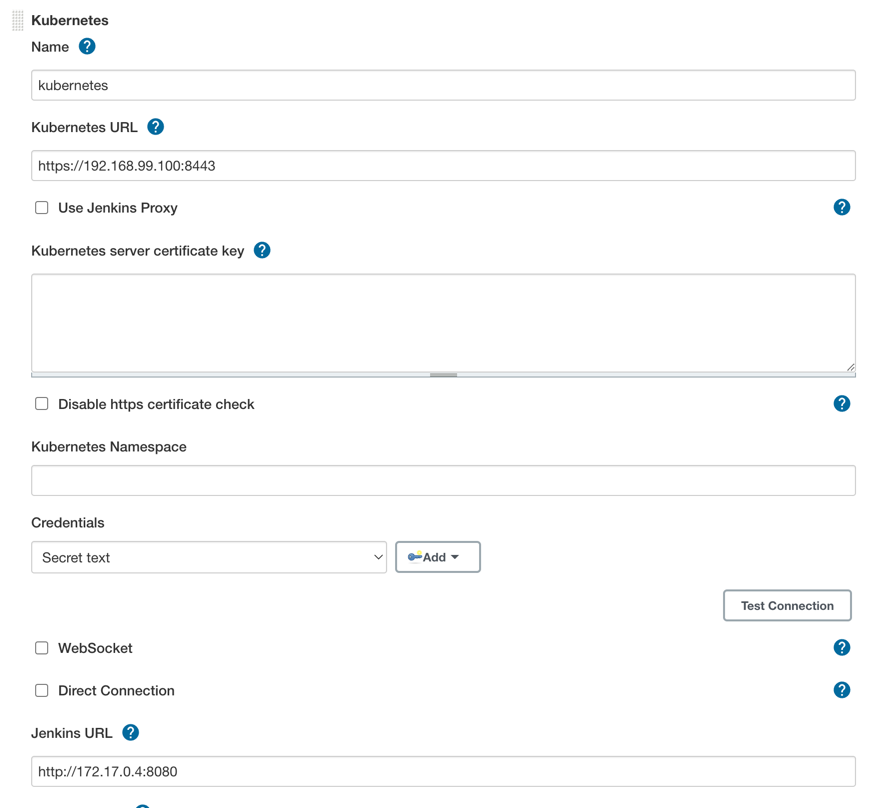
In some exceptional cases, agent pods can be left behind, with no declared Jenkins agent in the controller. They will try to reconnect over and over, until something deletes them.
The plugin provides a garbage collection mechanism to clean up these pods. As it has been introduced recently, and generates extra load on the Kubernetes API server, it is disabled by default.
Feel free to enable it and provide feedback about this functionality.

In addition to that, in the Kubernetes Pod Template section, we need to configure the image that will be used to spin up the agent pod. The Jenkins agent runs by default in a container named jnlp (historical name, kept for backward compatibility).
You may use it, use a different agent container name and/or provide your own container image.
To avoid drift between the Jenkins controller and your agent, we recommend not to include the agent JAR in your image, but instead use the Inject Jenkins agent in agent container checkbox.
The provided container image must have a JRE installed that is compatible with the Java version required by the Jenkins controller.
In the ‘Kubernetes Pod Template’ section you need to specify the following (the rest of the configuration is up to you): Kubernetes Pod Template Name - can be any and will be shown as a prefix for unique generated agent’ names, which will be run automatically during builds Docker image - the docker image name that will be used as a reference to spin up a new Jenkins agent, as seen below
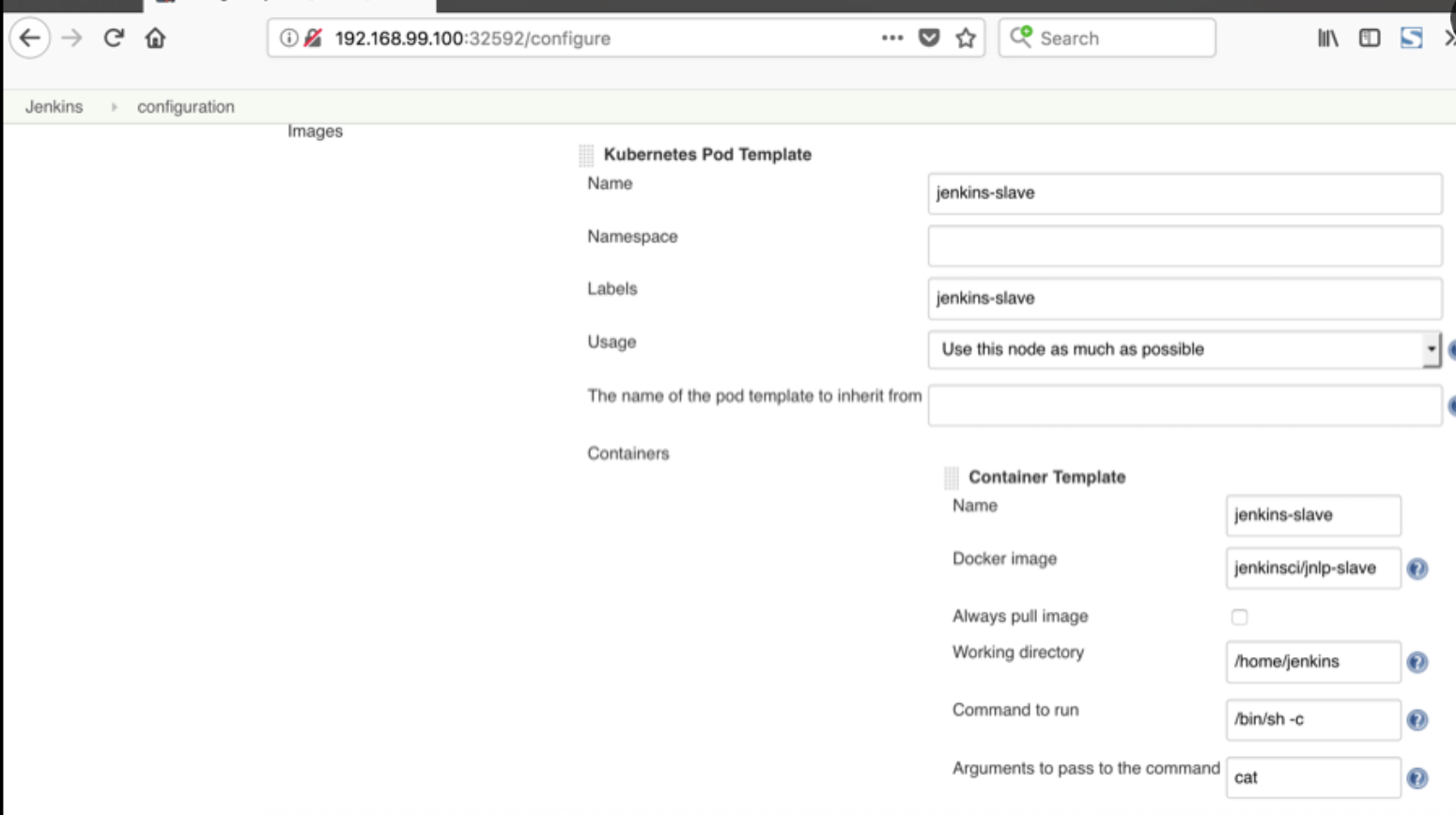
Note: If your Jenkins controller is outside the cluster and uses a self-signed HTTPS certificate, you will need some additional configuration.
Restricting what jobs can use your configured cloudClouds can be configured to only allow certain jobs to use them.
To enable this, in your cloud's advanced configuration check the Restrict pipeline support to authorized folders box. For a job to then use this cloud configuration you will need to add it in the jobs folder's configuration.
Usage OverviewThe Kubernetes plugin allocates Jenkins agents in Kubernetes pods.
Within these pods, there is always one special container that is running the Jenkins agent.
Its name defaults to jnlp, but you can override the name with one of your choosing in pod template configuration.
Other containers can run arbitrary processes of your choosing, and it is possible to run commands dynamically in any container in the agent pod using the container step (pipeline only).
Using a labelPod templates defined using the user interface declare a label. When a freestyle job or a pipeline job using node('some-label') uses a label declared by a pod template, the Kubernetes Cloud allocates a new pod to run the Jenkins agent.
It should be noted that the main reason to use the global pod template definition is to migrate a huge corpus of existing projects (including freestyle) to run on Kubernetes without changing job definitions. New users setting up new Kubernetes builds should use the podTemplate step as shown in the example snippets here.
Using the pipeline stepThe podTemplate step defines an ephemeral pod template. It is created while the pipeline execution is within the podTemplate block. It is immediately deleted afterwards. Such pod templates are not intended to be shared with other builds or projects in the Jenkins instance.
The following idiom creates a pod template with a generated unique label (available as POD_LABEL) and runs commands inside it.
podTemplate {node(POD_LABEL) {// pipeline steps...}}Commands will be executed by default in the designated agent container, where the Jenkins agent is running.
This will run in the agent container:
podTemplate {node(POD_LABEL) {stage('Run shell') {sh 'echo hello world'}}}Find more examples in the examples dir.
The default agent image used can be customized by adding it to the template
containerTemplate(name: 'jnlp', image: 'jenkins/inbound-agent', args: '${computer.jnlpmac} ${computer.name}'),or with the yaml syntax. Pretty much any field from the pod model can be specified through the yaml syntax.
apiVersion: v1kind: Podspec: containers: - name: jnlpimage: 'jenkins/inbound-agent'args: ['\$(JENKINS_SECRET)', '\$(JENKINS_NAME)'] Multiple containers supportMultiple containers can be defined for the agent pod, with shared resources, like mounts. Ports in each container can be accessed as in any Kubernetes pod, by using localhost.
One container must run the Jenkins agent. If unspecified, a container named jnlp will be created with the inbound-agent image. The Jenkins agent requires a JRE to run, so you can avoid the extra container by providing a name using the agentContainer. To get the Jenkins agent injected, you will also need to set agentInjection to true, and leave the command and argument fields empty for this container. The container specified by agentContainer will be the one where shell steps (or any other step running remote commands on the agent) will run on.
To execute commands in another container part of the pod (different from the one running the Jenkins agent), you can use the container step.
Note Due to implementation constraints, there can be issues when executing commands in different containers if they run using different uids. It is recommended to use the same uid across the different containers part of the same pod to avoid any issue. podTemplate( agentContainer: 'maven', agentInjection: true, containers: [containerTemplate(name: 'maven', image: 'maven:3.9.9-eclipse-temurin-17'),containerTemplate(name: 'golang', image: 'golang:1.16.5', command: 'sleep', args: '99d') ]) {node(POD_LABEL) {stage('Get a Maven project') {git 'https://github.com/jenkinsci/kubernetes-plugin.git'container('maven') {stage('Build a Maven project') {sh 'mvn -B -ntp clean install'}}}stage('Get a Golang project') {git url: 'https://github.com/hashicorp/terraform.git', branch: 'main'container('golang') {stage('Build a Go project') {sh '''mkdir -p /go/src/github.com/hashicorpln -s `pwd` /go/src/github.com/hashicorp/terraformcd /go/src/github.com/hashicorp/terraform && make'''}}}}}or
podTemplate( agentContainer: 'maven', agentInjection: true, yaml: '''apiVersion: v1kind: Podspec: containers: - name: mavenimage: maven:3.9.9-eclipse-temurin-17 - name: golangimage: golang:1.16.5command:- sleepargs:- 99d''') { node(POD_LABEL) {stage('Get a Maven project') { git 'https://github.com/jenkinsci/kubernetes-plugin.git' container('maven') {stage('Build a Maven project') { sh 'mvn -B -ntp clean install'} }}stage('Get a Golang project') { git url: 'https://github.com/hashicorp/terraform-provider-google.git', branch: 'main' container('golang') {stage('Build a Go project') { sh '''mkdir -p /go/src/github.com/hashicorpln -s `pwd` /go/src/github.com/hashicorp/terraformcd /go/src/github.com/hashicorp/terraform && make '''} }} }} POD_CONTAINER variableThe variable POD_CONTAINER contains the name of the container in the current context. It is defined only within a container block.
podTemplate(containers: […]) { node(POD_LABEL) {stage('Run shell') { container('mycontainer') {sh "echo hello from $POD_CONTAINER" // displays 'hello from mycontainer' }} }} Retrying after infrastructure outagesYou can use the retry step to automatically try the whole build stage again with a fresh pod in case of fatal infrastructure problems. (For example: cluster backup & restore; node pool used for agents drained and upgraded.)
podTemplate(…) { retry(count: 2, conditions: [kubernetesAgent(), nonresumable()]) {node(POD_LABEL) { sh 'your-build-process'} }}will rerun the whole node block (using the same pod definition) in case the first attempt fails for a qualifying reason traceable to loss of the pod (not routine problems such as compilation errors or OutOfMemoryError).
For Declarative Pipeline, just add the retries option, as shown below.
Configuration reference Pod templatePod templates are used to create agents. They can be either configured via the user interface, or in a pipeline, using the podTemplate step. Either way it provides access to the following fields:
cloud The name of the cloud as defined in Jenkins settings. Defaults to kubernetes name The name of the pod. This is only used for inheritance. namespace The namespace of the pod. label The node label. This is how the pod template can be referred to when asking for an agent through the node step. In a pipeline, it is recommended to omit this field and rely on the generated label that can be referred to using the POD_LABEL variable defined within the podTemplate block. yaml yaml representation of the Pod, to allow setting any values not supported as fields yamlMergeStrategy merge() or override(). Controls whether the yaml definition overrides or is merged with the yaml definition inherited from pod templates declared with inheritFrom. Defaults to override() (for backward compatibility reasons). containers The container templates part of the pod (see below for details). serviceAccount The service account of the pod. nodeSelector The node selector of the pod. nodeUsageMode Either NORMAL or EXCLUSIVE, this controls whether Jenkins only schedules jobs with label expressions matching or use the node as much as possible. volumes Volumes that are defined for the pod and are mounted by ALL containers. configMapVolume : a read only volume that is mounted from a ConfigMap.dynamicPVC() : a persistent volume claim managed dynamically. It is deleted at the same time as the pod.emptyDirVolume (default): an empty dir allocated on the host machinehostPathVolume() : a host path volumenfsVolume() : a nfs volumepersistentVolumeClaim() : an existing persistent volume claim by name.secretVolume : a read only volume that is mounted from a Kubernetes secret.envVars Environment variables that are applied to ALL containers. envVar An environment variable whose value is defined inline.secretEnvVar An environment variable whose value is derived from a Kubernetes secret.imagePullSecrets List of pull secret names, to pull images from a private Docker registry. annotations Annotations to apply to the pod. inheritFrom List of one or more pod templates to inherit from (more details below). slaveConnectTimeout Timeout in seconds for an agent to be online (more details below). podRetention Controls the behavior of keeping agent pods. Can be 'never()', 'onFailure()', 'always()', or 'default()' - if empty will default to deleting the pod after activeDeadlineSeconds has passed. activeDeadlineSeconds If podRetention is set to never() or onFailure(), the pod is deleted after this deadline is passed. idleMinutes Allows the pod to remain active for reuse until the configured number of minutes has passed since the last step was executed on it. showRawYaml Enable or disable the output of the raw pod manifest. Defaults to true runAsUser The user ID to run all containers in the pod as. runAsGroup The group ID to run all containers in the pod as. hostNetwork Use the hosts network. workspaceVolume The type of volume to use for the workspace. dynamicPVC() : a persistent volume claim managed dynamically. It is deleted at the same time as the pod.emptyDirWorkspaceVolume (default): an empty dir allocated on the host machinehostPathWorkspaceVolume() : a host path volumenfsWorkspaceVolume() : a nfs volumepersistentVolumeClaimWorkspaceVolume() : an existing persistent volume claim by name. Container templateContainer templates are part of pod. They can be configured via the user interface or in a pipeline and allow you to set the following fields:
name The name of the container. image The image of the container. envVars Environment variables that are applied to the container (supplementing and overriding env vars that are set on pod level). envVar An environment variable whose value is defined inline.secretEnvVar An environment variable whose value is derived from a Kubernetes secret.command The command the container will execute. Will overwrite the Docker entrypoint. A typical value is sleep. args The arguments passed to the command. A typical value is 99999999. ttyEnabled Flag to mark that tty should be enabled. livenessProbe Parameters to be added to a exec liveness probe in the container (does not support httpGet liveness probes) ports Expose ports on the container. alwaysPullImage The container will pull the image upon starting. runAsUser The user ID to run the container as. runAsGroup The group ID to run the container as.Specifying a different default agent connection timeoutBy default, the agent connection timeout is set to 1000 seconds. It can be customized using a system property. Please refer to the section below.
Using yaml to define Pod TemplatesIn order to support any possible value in Kubernetes Pod object, we can pass a yaml snippet that will be used as a base for the template. If any other properties are set outside the YAML, they will take precedence.
podTemplate(yaml: '''apiVersion: v1kind: Podmetadata: labels: some-label: some-label-valuespec: containers: - name: busyboximage: busyboxcommand:- sleepargs:- 99d''') {node(POD_LABEL) { container('busybox') {echo POD_CONTAINER // displays 'busybox'sh 'hostname' }}}You can use readFile or readTrusted steps to load the yaml from a file. Also note that in declarative pipelines the yamlFile can be used (see this example).
Examplepod.yaml
apiVersion: v1kind: Podspec: containers: - name: mavenimage: maven:3.9.9-eclipse-temurin-17command:- sleepargs:- 99d - name: golangimage: golang:1.16.5command:- sleepargs:- 99dJenkinsfile
podTemplate(yaml: readTrusted('pod.yaml')) { node(POD_LABEL) {// ... }} Liveness Probe Usage containerTemplate(name: 'busybox', image: 'busybox', command: 'sleep', args: '99d', livenessProbe: containerLivenessProbe(execArgs: 'some --command', initialDelaySeconds: 30, timeoutSeconds: 1, failureThreshold: 3, periodSeconds: 10, successThreshold: 1))See Defining a liveness command for more details.
Inheritance OverviewA pod template may or may not inherit from an existing template.
Depending on fields, the inheritance behaviour can vary. For simple values (strings), the child template will override the parent template. However for complex values (lists, maps), the child template will merge with the parent template.
yaml is merged according to the value of yamlMergeStrategy specified in the child pod template. Service account and Node selector when are overridden completely substitute any possible value found on the 'parent'. Container templates that are added to the podTemplate, that has a matching containerTemplate (a container template with the same name) in the 'parent' template, will inherit the configuration of the parent containerTemplate. If no matching container template is found, the template is added as is. Volume inheritance works exactly as Container templates. Image Pull Secrets are combined (all secrets defined both on 'parent' and 'current' template are used).In the example below, we will inherit from a pod template we created previously, and will just override the version of maven so that it uses Java 21 instead:
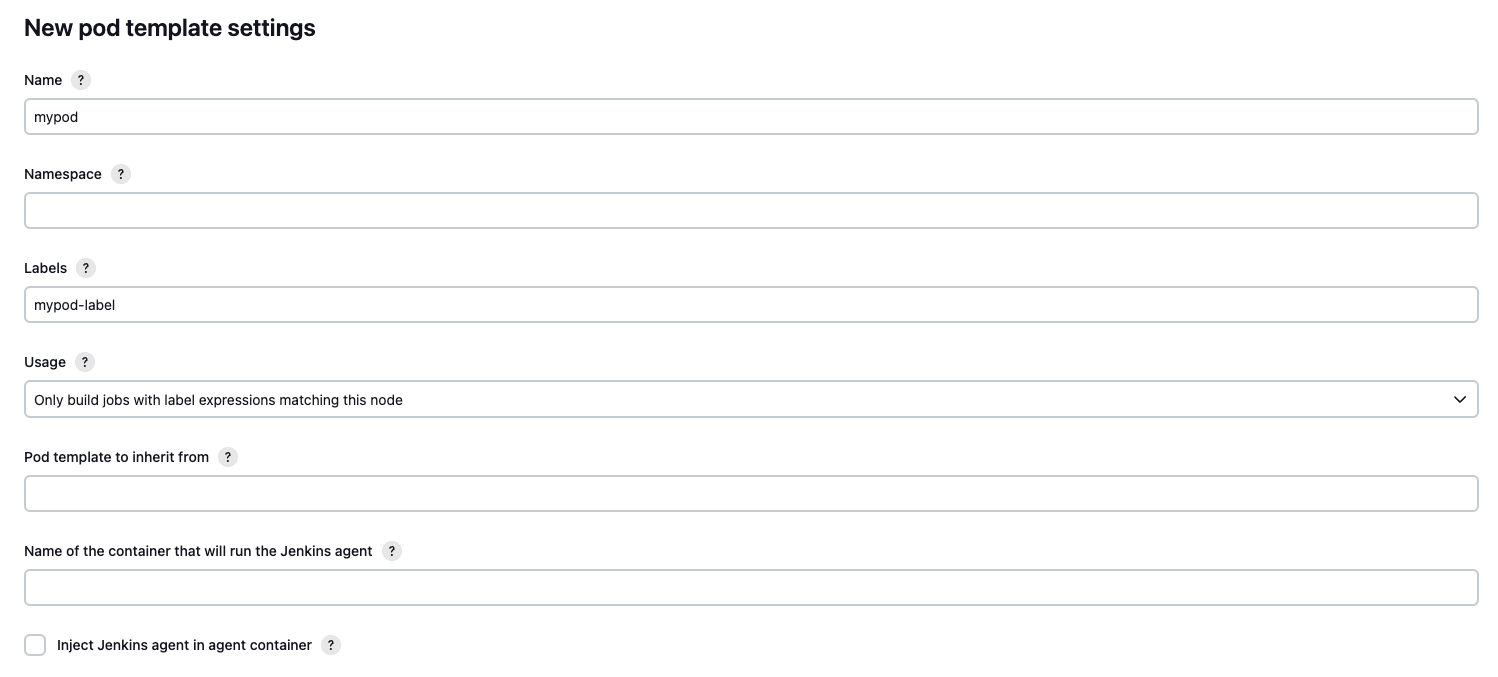
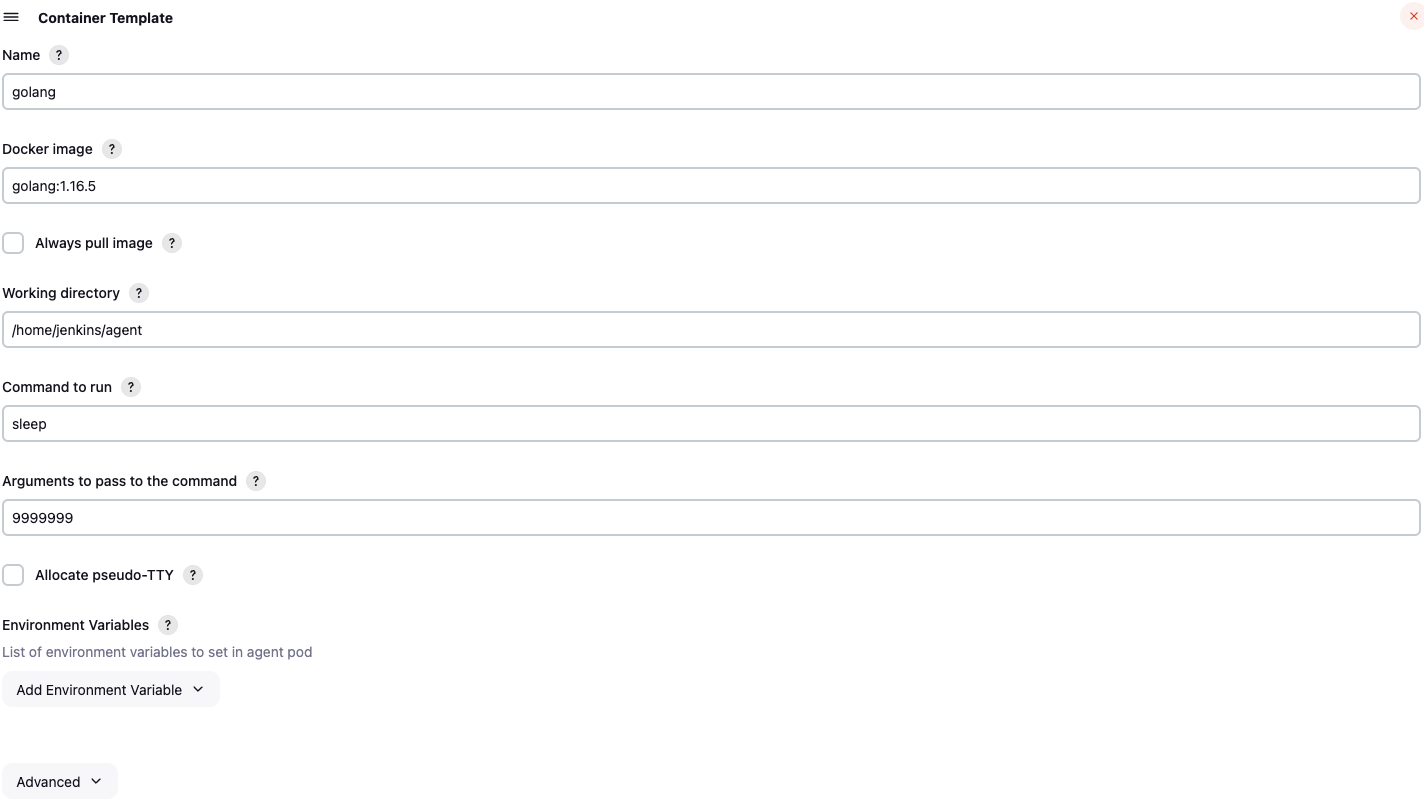
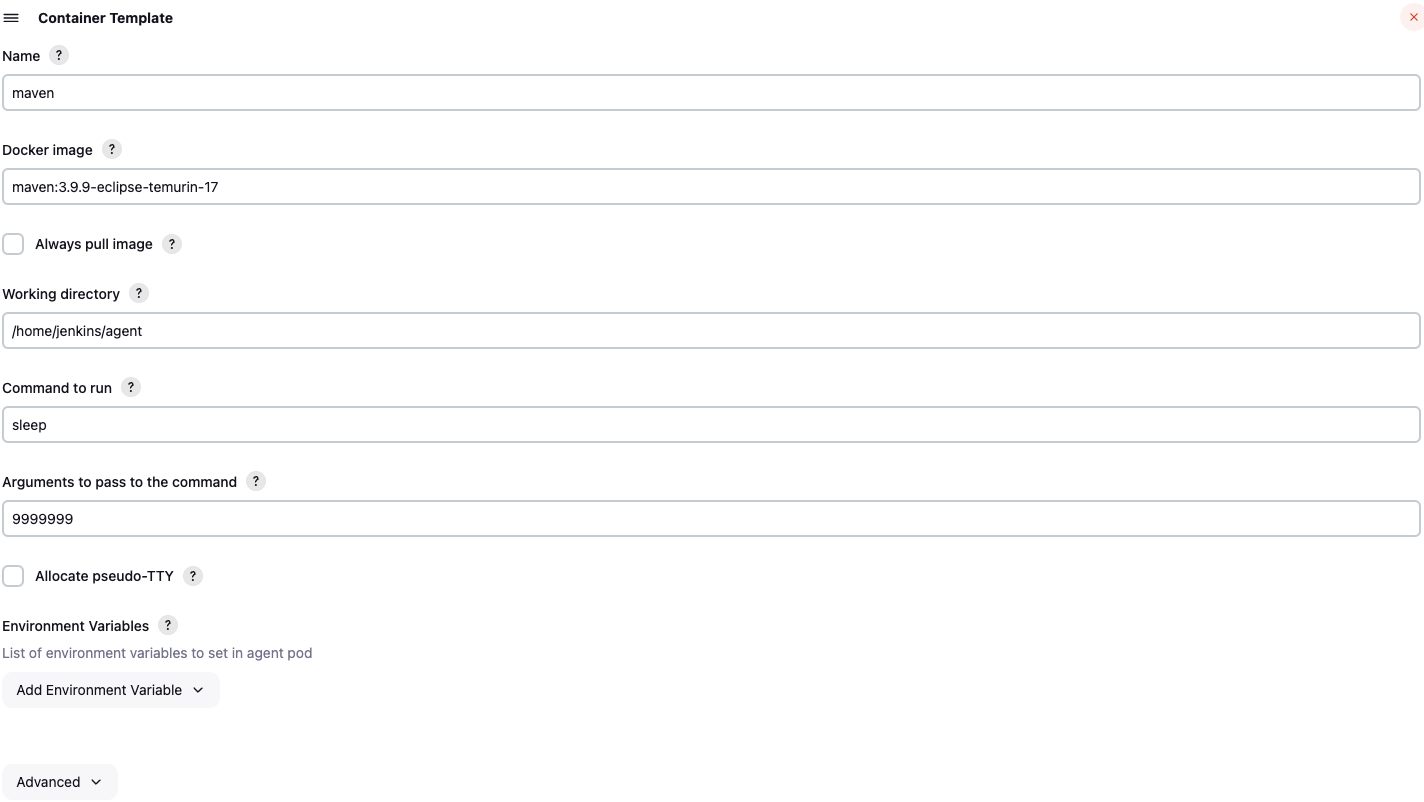
Or in declarative pipeline
pipeline { agent {kubernetes { inheritFrom 'mypod' yaml ''' spec:containers:- name: maven image: maven:3.9.9-eclipse-temurin-21''' …} } stages {… }}Note that we only need to specify the things that are different. So, command and arguments are not specified, as they are inherited. Also, the golang container will be added as defined in the 'parent' template.
Multiple Pod template inheritanceField inheritFrom may refer a single pod template or multiple separated by space. In the later case each template will be processed in the order they appear in the list (later items overriding earlier ones). In any case if the referenced template is not found it will be ignored.
Nesting Pod templatesField inheritFrom provides an easy way to compose pod templates that have been pre-configured. In many cases it would be useful to define and compose pod templates directly in the pipeline using groovy. This is made possible via nesting. You can nest multiple pod templates together in order to compose a single one.
The example below composes two different pod templates in order to create one with maven and docker capabilities.
podTemplate(containers: [containerTemplate(image: 'docker', name: 'docker', command: 'sleep', args: '99d')]) {podTemplate(containers: [containerTemplate(image: 'maven', name: 'maven', command: 'sleep', args: '99d')]) { node(POD_LABEL) { // gets a pod with both docker and maven… }}}This feature is extra useful, pipeline library developers as it allows you to wrap pod templates into functions and let users nest those functions according to their needs.
For example one could create functions for their podTemplates and import them for use. Say here's our file src/com/foo/utils/PodTemplates.groovy:
package com.foo.utilspublic void dockerTemplate(body) { podTemplate(containers: [containerTemplate(name: 'docker', image: 'docker', command: 'sleep', args: '99d')],volumes: [hostPathVolume(hostPath: '/var/run/docker.sock', mountPath: '/var/run/docker.sock')]) {body.call()}}public void mavenTemplate(body) { podTemplate(containers: [containerTemplate(name: 'maven', image: 'maven', command: 'sleep', args: '99d')],volumes: [secretVolume(secretName: 'maven-settings', mountPath: '/root/.m2'), persistentVolumeClaim(claimName: 'maven-local-repo', mountPath: '/root/.m2repo')]) {body.call()}}return thisThen consumers of the library could just express the need for a maven pod with docker capabilities by combining the two, however once again, you will need to express the specific container you wish to execute commands in. You can NOT omit the node statement.
Note that POD_LABEL will be the innermost generated label to get a node which has all the outer pods available on the node, as shown in this example:
import com.foo.utils.PodTemplatespodTemplates = new PodTemplates()podTemplates.dockerTemplate { podTemplates.mavenTemplate {node(POD_LABEL) { container('docker') {sh "echo hello from $POD_CONTAINER" // displays 'hello from docker' } container('maven') {sh "echo hello from $POD_CONTAINER" // displays 'hello from maven' } } }}In scripted pipelines, there are cases where this implicit inheritance via nested declaration is not wanted or another explicit inheritance is preferred. In this case, use inheritFrom '' to remove any inheritance, or inheritFrom 'otherParent' to override it.
Declarative PipelineDeclarative agents can be defined from yaml
pipeline { agent {kubernetes { yaml '''apiVersion: v1kind: Podmetadata: labels:some-label: some-label-valuespec: containers: - name: mavenimage: maven:3.9.9-eclipse-temurin-17command:- cattty: true - name: busyboximage: busyboxcommand:- cattty: true''' retries 2} } stages {stage('Run maven') { steps {container('maven') { sh 'mvn -version'}container('busybox') { sh '/bin/busybox'} }} }}or using yamlFile to keep the pod template in a separate KubernetesPod.yaml file
pipeline { agent {kubernetes { yamlFile 'KubernetesPod.yaml' retries 2} } stages {… }}Note that it was previously possible to define containerTemplate but that has been deprecated in favor of the yaml format.
pipeline { agent {kubernetes { //cloud 'kubernetes' containerTemplate {name 'maven'image 'maven:3.9.9-eclipse-temurin-17'command 'sleep'args '99d' }} } stages {… }}Run steps within a container by default. Steps will be nested within an implicit container(name) {...} block instead of being executed in the agent container.
pipeline { agent {kubernetes { defaultContainer 'maven' yamlFile 'KubernetesPod.yaml'} } stages {stage('Run maven') { steps {sh 'mvn -version' }} }}Run the Pipeline or individual stage within a custom workspace - not required unless explicitly stated.
pipeline { agent {kubernetes { customWorkspace 'some/other/path' defaultContainer 'maven' yamlFile 'KubernetesPod.yaml'} } stages {stage('Run maven') { steps {sh 'mvn -version'sh "echo Workspace dir is ${pwd()}" }} }} Default inheritanceUnlike scripted k8s template, declarative templates do not inherit from parent template. Since the agents declared at stage level can override a global agent, implicit inheritance was leading to confusion.
You need to explicitly declare the inheritance if necessary using the field inheritFrom.
In the following example, nested-pod will only contain the maven container.
pipeline { agent {kubernetes { yaml '''spec:containers:- name: golangimage: golang:1.16.5command:- sleepargs:- 99d'''} } stages {stage('Run maven') {agent {kubernetes {yaml '''spec:containers:- name: maven image: maven:3.9.9-eclipse-temurin-17 command: - sleep args: - 99d'''}} steps {… }} }} Misc. Accessing container logs from the pipelineIf you use the containerTemplate to run some service in the background (e.g. a database for your integration tests), you might want to access its log from the pipeline. This can be done with the containerLog step, which prints the log of the requested container to the build log.
Required Parametersname the name of the container to get logs from, as defined in podTemplate. Parameter name can be omitted in simple usage:containerLog 'mongodb' Optional ParametersreturnLog return the log instead of printing it to the build log (default: false) tailingLines only return the last n lines of the log (optional) sinceSeconds only return the last n seconds of the log (optional) limitBytes limit output to n bytes (from the beginning of the log, not exact).Also see the online help and examples/containerLog.groovy.
Features controlled using system propertiesPlease read Features controlled by system properties page to know how to set up system properties within Jenkins.
KUBERNETES_JENKINS_URL : Jenkins URL to be used by agents. This is meant to be used for OEM integration. io.jenkins.plugins.kubernetes.disableNoDelayProvisioning (since 1.19.1) Whether to disable the no-delay provisioning strategy the plugin uses (defaults to false). io.jenkins.plugins.kubernetes.NoDelayProvisionerStrategy.disableCloudShuffle Whether to disable the shuffling of clouds. When true clouds will be searched in order they are defined (defaults to false). jenkins.host.address : (for unit tests) controls the host agents should use to contact Jenkins org.csanchez.jenkins.plugins.kubernetes.PodTemplate.connectionTimeout : The time in seconds to wait before considering the pod scheduling has failed (defaults to 1000) org.csanchez.jenkins.plugins.kubernetes.pipeline.ContainerExecDecorator.stdinBufferSize : stdin buffer size in bytes for commands sent to Kubernetes exec api. A low value will cause slowness in commands executed. A higher value will consume more memory (defaults to 16*1024) org.csanchez.jenkins.plugins.kubernetes.pipeline.ContainerExecDecorator.websocketConnectionTimeout : Time to wait for the websocket used by container step to connect (defaults to 30)Running on OpenShift Random UID problemOpenShift runs containers using a random UID that is overriding what is specified in Docker images. For this reason, you may end up with the following warning in your build
[WARNING] HOME is set to / in the agent container. You may encounter troubles when using tools or ssh client. This usually happens if the uid doesnt have any entry in /etc/passwd. Please add a user to your Dockerfile or set the HOME environment variable to a valid directory in the pod template definition.At the moment the jenkinsci agent image is not built for OpenShift and will issue this warning.
This issue can be circumvented in various ways:
build a docker image for OpenShift in order to behave when running using an arbitrary uid. override HOME environment variable in the pod spec to use /home/jenkins and mount a volume to /home/jenkins to ensure the user running the container can write to itSee this example configuration.
Running with OpenShift 3OpenShift 3 is based on an older version of Kubernetes, which is not anymore directly supported since Kubernetes plugin version 1.26.0.
To get agents working for Openshift 3, add this Node Selector to your Pod Templates:
beta.kubernetes.io/os=linux Windows supportYou can run pods on Windows if your cluster has Windows nodes. See the example.
Configuration on minikubeCreate and start minikube
The client certificate needs to be converted to PKCS, will need a password
openssl pkcs12 -export -out ~/.minikube/minikube.pfx -inkey ~/.minikube/apiserver.key -in ~/.minikube/apiserver.crt -certfile ~/.minikube/ca.crt -passout pass:secretValidate that the certificates work
curl --cacert ~/.minikube/ca.crt --cert ~/.minikube/minikube.pfx:secret --cert-type P12 https://$(minikube ip):8443Add a Jenkins credential of type certificate, upload it from ~/.minikube/minikube.pfx, password secret
Fill Kubernetes server certificate key with the contents of ~/.minikube/ca.crt
Configuration on Google Container EngineCreate a cluster
gcloud container clusters create jenkins --num-nodes 1 --machine-type g1-smalland note the admin password and server certificate.
Or use Google Developer Console to create a Container Engine cluster, then run
gcloud container clusters get-credentials jenkinskubectl config view --rawthe last command will output kubernetes cluster configuration including API server URL, admin password and root certificate
TroubleshootingFirst watch if the Jenkins agent pods are started. Make sure you are in the correct cluster and namespace.
kubectl get -a pods --watchIf they are in a different state than Running, use describe to get the events
kubectl describe pods/my-jenkins-agentIf they are Running, use logs to get the log output
kubectl logs -f pods/my-jenkins-agent jnlpIf pods are not started or for any other error, check the logs on the controller side.
For more detail, configure a new Jenkins log recorder for org.csanchez.jenkins.plugins.kubernetes at ALL level.
To inspect the json messages sent back and forth to the Kubernetes API server you can configure a new Jenkins log recorder for okhttp3 at DEBUG level.
Deleting pods in bad state kubectl get pods -o name --selector=jenkins=slave --all-namespaces | xargs -I {} kubectl delete {} Pipeline sh step hangs when multiple containers are usedTo debug this you need to set -Dorg.jenkinsci.plugins.durabletask.BourneShellScript.LAUNCH_DIAGNOSTICS=true system property and then restart the pipeline. Most likely in the console log you will see the following:
sh: can't create /home/jenkins/agent/workspace/thejob@tmp/durable-e0b7cd27/jenkins-log.txt: Permission deniedsh: can't create /home/jenkins/agent/workspace/thejob@tmp/durable-e0b7cd27/jenkins-result.txt.tmp: Permission deniedmv: can't rename '/home/jenkins/agent/workspace/thejob@tmp/durable-e0b7cd27/jenkins-result.txt.tmp': No such file or directorytouch: /home/jenkins/agent/workspace/thejob@tmp/durable-e0b7cd27/jenkins-log.txt: Permission deniedtouch: /home/jenkins/agent/workspace/thejob@tmp/durable-e0b7cd27/jenkins-log.txt: Permission deniedtouch: /home/jenkins/agent/workspace/thejob@tmp/durable-e0b7cd27/jenkins-log.txt: Permission deniedUsually this happens when UID of the user in agent container differs from the one in another container(s). All containers you use should have the same UID of the user, also this can be achieved by setting securityContext:
apiVersion: v1kind: Podspec: securityContext:runAsUser: 1000 # default UID of jenkins user in agent image containers: - name: mavenimage: maven:3.9.9-eclipse-temurin-17command:- cattty: true Using WebSockets with a Jenkins controller with self-signed HTTPS certificateUsing WebSockets is the easiest and recommended way to establish the connection between agents and a Jenkins controller running outside the cluster. However, if your Jenkins controller has HTTPS configured with self-signed certificate, you'll need to make sure the agent container trusts the CA. To do that, you can extend the jenkins/inbound-agent image and add your certificate as follows:
FROM jenkins/inbound-agentUSER rootADD cert.pem /tmp/cert.pemRUN keytool -noprompt -storepass changeit -cacerts \ -import -file /tmp/cert.pem -alias jenkinsMaster && \ rm -f /tmp/cert.pemUSER jenkinsThen, use it as the agent container for the pod template as usual. No command or args need to be specified.
Notes:
Support for using WebSockets with JDK 11 was added in the Remoting v4.11, so make sure your base image is new enough. See here for more information.
When using the WebSocket mode, the -disableHttpsCertValidation on the jenkins/inbound-agent becomes unavailable, as well as -cert, and that's why you have to extend the docker image.
[WARNING] label option is deprecated [WARNING] label option is deprecated. To use a static pod template, use the 'inheritFrom' option.You need to change from something like:
agent {kubernetes {label 'somelabel'}}To something like:
agent {kubernetes {inheritFrom 'somelabel'}} Building and TestingIntegration tests will use the currently configured context auto-detected from kube config file or service account.
Manual TestingRun mvn clean install and copy target/kubernetes.hpi to Jenkins plugins folder.
Running Kubernetes Integration TestsSet up your $KUBECONFIG however you like, for example
kind create clusterthen
kubectl krew install tunnel # as needed; install Krew firstkubectl tunnel expose jenkins 8000:8000 8001:8001 &mvn test -Djenkins.host.address=jenkins.default -Dport=8000 -DslaveAgentPort=8001 -Dtest=KubernetesPipelineTest#runInPodAlternately, you can run everything like in CI:
export KIND_PRELOAD=true # optionally./kind.sh -Dtest=KubernetesPipelineTest#runInPodYou can also run interactively after setting up the tunnel:
mvn hpi:run -Djenkins.host.address=jenkins.default -Dport=8000 -Djenkins.model.Jenkins.slaveAgentPort=8001 Docker imageDocker image for Jenkins, with plugin installed. Based on the official image.
Running the Docker image docker run --rm --name jenkins -p 8080:8080 -p 50000:50000 -v /var/jenkins_home csanchez/jenkins-kubernetes Running in KubernetesThe example configuration will create a stateful set running Jenkins with persistent volume and using a service account to authenticate to Kubernetes API.
Running locally with minikubeA local testing cluster with one node can be created with minikube
minikube startYou may need to set the correct permissions for host mounted volumes
minikube sshsudo chown 1000:1000 /tmp/hostpath-provisioner/pvc-*Then create the Jenkins namespace, controller and Service with
kubectl create namespace kubernetes-pluginkubectl config set-context $(kubectl config current-context) --namespace=kubernetes-pluginkubectl create -f src/main/kubernetes/service-account.ymlkubectl create -f src/main/kubernetes/jenkins.ymlGet the url to connect to with
minikube service jenkins --namespace kubernetes-plugin --url Running in Google Container Engine GKEAssuming you created a Kubernetes cluster named jenkins this is how to run both Jenkins and agents there.
Creating all the elements and setting the default namespace
kubectl create namespace kubernetes-pluginkubectl config set-context $(kubectl config current-context) --namespace=kubernetes-pluginkubectl create -f src/main/kubernetes/service-account.ymlkubectl create -f src/main/kubernetes/jenkins.ymlConnect to the ip of the network load balancer created by Kubernetes, port 80. Get the ip (in this case 104.197.19.100) with kubectl describe services/jenkins (it may take a bit to populate)
$ kubectl describe services/jenkinsName:jenkinsNamespace: defaultLabels: Selector:name=jenkinsType:LoadBalancerIP: 10.175.244.232LoadBalancer Ingress:104.197.19.100Port:http80/TCPNodePort:http30080/TCPEndpoints: 10.172.1.5:8080Port:agent50000/TCPNodePort:agent32081/TCPEndpoints: 10.172.1.5:50000Session Affinity:NoneNo events.Until Kubernetes 1.4 removes the SNATing of source ips, seems that CSRF (enabled by default in Jenkins 2) needs to be configured to avoid WARNING: No valid crumb was included in request errors. This can be done checking Enable proxy compatibility under Manage Jenkins -> Configure Global Security
Configure Jenkins, adding the Kubernetes cloud under configuration, setting Kubernetes URL to the container engine cluster endpoint or simply https://kubernetes.default.svc.cluster.local. Under credentials, click Add and select Kubernetes Service Account, or alternatively use the Kubernetes API username and password. Select 'Certificate' as credentials type if the kubernetes cluster is configured to use client certificates for authentication.
Using Kubernetes Service Account will cause the plugin to use the default token mounted inside the Jenkins pod. See Configure Service Accounts for Pods for more information.

You may want to set Jenkins URL to the internal service IP, http://10.175.244.232 in this case, to connect through the internal network.
Set Container Cap to a reasonable number for tests, i.e. 3.
Add an image with
Docker image: jenkins/inbound-agent Jenkins agent root directory: /home/jenkins/agent
Now it is ready to be used.
Tearing it down
kubectl delete namespace/kubernetes-plugin Customizing the deployment Modify CPUs and memory request/limits (Kubernetes Resource API)Modify file ./src/main/kubernetes/jenkins.yml with desired limits
resources: limits:cpu: 1memory: 1Gi requests:cpu: 0.5memory: 500MiNote: the JVM will use the memory requests as the heap limit (-Xmx)
Building docker build -t csanchez/jenkins-kubernetes . Related ProjectsKubernetes Pipeline plugin: pipeline extension to provide native support for using Kubernetes pods, secrets and volumes to perform builds kubernetes-credentials: Credentials provider that reads Kubernetes secrets